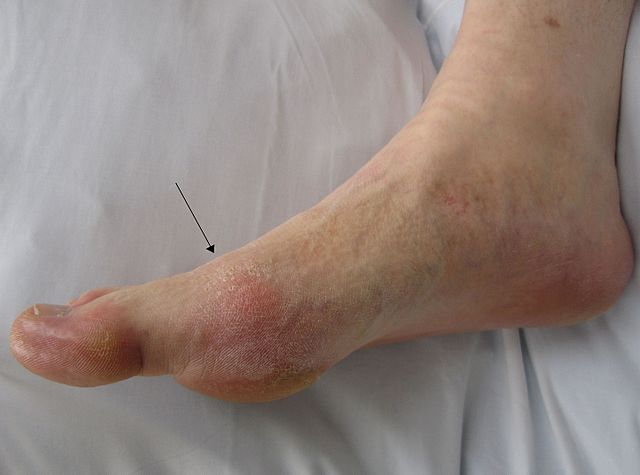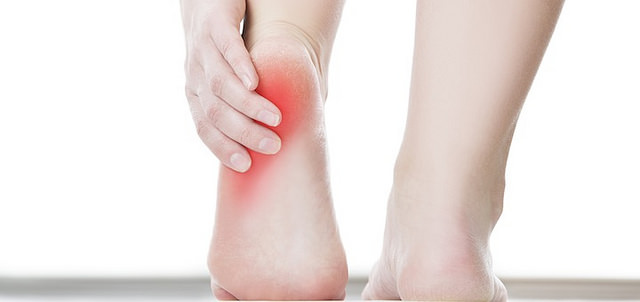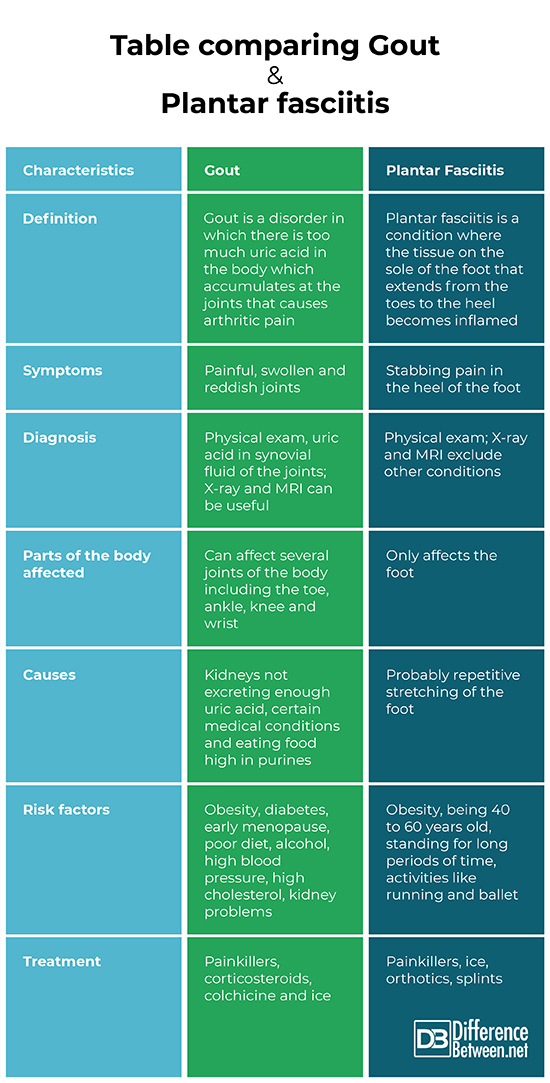Difference between Gout and Plantar Fasciitis
What is Gout?
Definition of Gout:
Gout is a disorder in which there is too much uric acid (hyperuricemia) in the body with the result that uric acid crystals form in the joints which in turn causes arthritic pain. Gout is most commonly evident in the joint of the big toe but other joints such as the ankle, instep, knee, wrist and even the elbow, can be affected.
Symptoms and diagnosis of Gout:

Symptoms include pain in the joints that is acute and severe. Joints may also swell, be warm and reddish in color. Diagnosis is by physical exam in which certain symptoms are noted; especially problems with the big toe joint. Diagnosis can be confirmed by taking a sample of synovial fluid from the afflicted joint and looking for the presence of uric acid crystals. X-rays and ultrasound can also be helpful in the diagnosis of gout since they can sometimes show the presence of bone lesions.
Causes of Gout:
The cause of gout is most often due to the kidneys not excreting enough uric acid. However, gout only develops in some people and not others. The reason for this is not known but may be due to hereditary. Excess levels of uric acid can occur in people who have leukemia, lymphoma, and hemolytic anemia. Eating foods that are high in purines can also add to the problem.
Risk factors and complications:
Risk factors for gout include diet, drinking alcohol, obesity, having diabetes, early menopause, having high cholesterol, high blood pressure, and kidney problems. Complications of gout include joint deterioration and a higher risk of kidney stones. Another complication that can occur is the formation of tophi, which are swollen nodules of urate crystals that form under the skin.
Prevention and treatment for Gout:
It is a good idea to have a healthy weight and eat a healthy diet including reducing your intake of foods that are high in purines. Certain red meats, certain fish, and even some vegetables are high in purines. Treatment includes the use of nonsteroidal anti-inflammatory medications and corticosteroids and colchicine. Icing the joint and splinting of the joint can sometimes help as well.

What is Plantar fasciitis?
Definition of Plantar fasciitis:
Plantar fasciitis is a condition in which the tissue that extends from the heel to the toes (on the sole of the foot), becomes inflamed. It is a very common cause of pain in the heel of the foot.
Symptoms and diagnosis:
Symptoms are a pain in the heel of the foot, which can be described as stabbing pain that becomes worse after exercise or after you have been resting for a while. Diagnosis of the condition is made by physical exam. Other conditions are excluded by using imaging techniques such as X- rays and MRI.
Causes of Plantar fasciitis:
The actual cause of plantar fasciitis is debatable but it does seem that the condition occurs from repetitive stretching that leads to tearing of the tissue. This means that engaging in certain activities affecting the feet and having an occupation with a lot of standing may cause the condition.
Risk factors and complications:
Risk factors include being between 40 and 60 years of age, being obese, standing on your feet a long time and engaging in certain activities such as running or ballet. Having a high arch to your foot or being flat footed can also increase your risk of developing plantar fasciitis. Complications may include reduced sensation or a feeling of numbness in the foot, rupture of the tissue of the foot and flattening of the foot arch.
Prevention and treatment for Plantar fasciitis:
Prevention includes buying and wearing good footwear and maintaining a healthy body weight. Being obese puts extra strain on your feet. Treatment includes the use of painkillers including nonsteroidal anti-inflammatories and icing the area. Foot orthotics and night splints may also be helpful.
Difference between Gout and Plantar fasciitis?
-
Definition
Gout is a disorder in which there is too much uric acid in the body. The result of this is that uric acid crystals form in the joints which in turn causes arthritic pain. Plantar fasciitis is a condition in which the tissue that extends from the toes to the heel becomes inflamed.
-
Symptoms
Symptoms of gout include pain in the joints and swollen and reddish joints. Symptoms of plantar fasciitis include a stabbing pain in the heel of the foot.
-
Diagnosis
Gout is diagnosed by physical exam and the presence of uric acid crystals in the synovial fluid of the joints; MRI and X-rays can also be helpful. Plantar fasciitis is diagnosed by physical exam and by using MRI and X-rays to exclude other conditions.
-
Parts of the body affected
Gout can affect several joints of the body including the toe, ankle, knee, and wrist. Plantar fasciitis only affects the foot.
-
Causes
Gout can be caused by kidneys not excreting enough uric acid. It can be because of certain medical conditions and from eating foods high in purines. Plantar fasciitis is thought to probably be caused by repetitive stretching of the foot.
-
Risk factors
Risk factors for gout include being obese, having diabetes, early menopause, poor diet, drinking alcohol, having high blood pressure, having high cholesterol and kidney problems. Risk factors for plantar fasciitis include being between 40 and 60 years, being obese, standing for long periods of time and engaging in activities such as running and ballet.
-
Treatment
Treatment of gout includes nonsteroidal painkillers, cortisone, colchicine, and ice. Treatment of plantar fasciitis includes nonsteroidal painkillers, orthotics, splints, and ice.
Table comparing Gout and Plantar fasciitis

Summary of Gout Vs. Plantar fasciitis
- Gout is a condition in which uric acid builds up in the joints causing pain.
- Plantar fasciitis is a condition in which the tissue extending from the toes to the heel becomes inflamed.
- Both gout and plantar fasciitis are very painful and can be treated with painkillers.
- Difference Between Rumination and Regurgitation - June 13, 2024
- Difference Between Pyelectasis and Hydronephrosis - June 4, 2024
- Difference Between Cellulitis and Erysipelas - June 1, 2024
Search DifferenceBetween.net :
1 Comment
Leave a Response
References :
[0]Edwards, N. Lawrence. “Gout”. Merckmanuals. Merck & Co., 2018, https://www.msdmanuals.com/professional/musculoskeletal-and-connective-tissue-disorders/crystal-induced-arthritides/gout
[1]Riddle, Daniel L., et al. "Risk factors for plantar fasciitis: a matched case-control study." JBJS 85.5 (2003): 872-877.
[2]Singh, Jasvinder A., Supriya G. Reddy, and Joseph Kundukulam. "Risk factors for gout and prevention: a systematic review of the literature." Current opinion in rheumatology 23.2 (2011): 192.
[3]Image credit: https://www.flickr.com/photos/35080385@N08/30956691112
[4]Image credit: https://upload.wikimedia.org/wikipedia/commons/thumb/2/28/Gout2010.JPG/640px-Gout2010.JPG

The back of my heel hurts so bad can’t stand anything to touch it that plantar fasciitis?